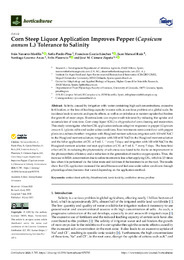Por favor, use este identificador para citar o enlazar este ítem:
https://hdl.handle.net/11000/33466
Corn Steep Liquor Application Improves Pepper (Capsicum annum L.) Tolerance to Salinity
Título :
Corn Steep Liquor Application Improves Pepper (Capsicum annum L.) Tolerance to Salinity |
Autor :
Navarro Morillo, Iván 
Pardo Pina, Sofía
Garcia-Sanchez, Francisco 
Ruiz Sáez, Juan Manuel 
Laserna-Arcas, Santiago
Plasencia Martínez, Félix Antonio 
Cámara-Zapata, José-María  |
Editor :
MDPI |
Departamento:
Departamentos de la UMH::Física Aplicada |
Fecha de publicación:
2023-07-10 |
URI :
https://hdl.handle.net/11000/33466 |
Resumen :
Salinity, caused by irrigation with water containing high salt concentrations, excessive fertilization, or the loss of leaching capacity in some soils, is a serious problem on a global scale. Its incidence leads to osmotic and specific effects, as well as an imbalance in nutrient uptake that hinders the growth of most crops. Biostimulants can improve salt tolerance by reducing the uptake and accumulation of toxic ions. Corn steep liquor (CSL) is a byproduct of corn cleaning and maceration. This study investigates whether CSL application induces adaptive responses in pepper (Capsicum annuum L.) plants cultivated under saline conditions. Four treatments were carried out with pepper plants in a culture chamber: irrigation with Hoagland nutrient solution; irrigation with 100 mM NaCl in the Hoagland nutrient solution; irrigation with 100 mM NaCl in the Hoagland nutrient solution and the foliar application of CSL at 5 mL L−1 every 7 days; and irrigation with 100 mM NaCl in the Hoagland nutrient solution and root application of CSL at 5 mL L−1 every 7 days. The beneficial effect of CSL in reducing the phytotoxicity of salt stress was found to be due to an improvement in the photosynthetic efficiency and a reduction in the generation of reactive oxygen species. Thus, the increase in MDA concentration due to saline treatment is less when applying CSL, which is 3.5 times less when it is performed via the foliar route and 4.6 times if the treatment is on the root. The results show that CSL application increased the aerial biomass and leaf area under saline conditions through physiological mechanisms that varied depending on the application method
|
Palabras clave/Materias:
Antioxidant activity
Biostimulant
Ionic toxicity
Oxidative stress
Proline |
Tipo de documento :
info:eu-repo/semantics/article |
Derechos de acceso:
info:eu-repo/semantics/openAccess
Attribution-NonCommercial-NoDerivatives 4.0 Internacional |
DOI :
https://doi.org/10.3390/horticulturae9070785 |
Publicado en:
Horticulturae 2023, 9(7) |
Aparece en las colecciones:
Artículos Física Aplicada
|
 La licencia se describe como: Atribución-NonComercial-NoDerivada 4.0 Internacional.
La licencia se describe como: Atribución-NonComercial-NoDerivada 4.0 Internacional.

 La licencia se describe como: Atribución-NonComercial-NoDerivada 4.0 Internacional.
La licencia se describe como: Atribución-NonComercial-NoDerivada 4.0 Internacional.
.png)